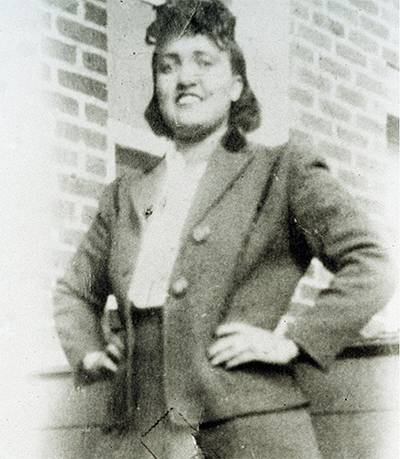- Name
- Johns Hopkins Medicine media relations
- JHMedia@jhmi.edu
- Office phone
- 410-955-6681
The Johns Hopkins University and Johns Hopkins Medicine today announced that the on-campus building project named in honor of Henrietta Lacks, the Baltimore County woman whose cells have advanced medicine around the world, will be designed and managed by local and/or minority-owned businesses, including Vines Architecture and local Baltimore construction firm Mahogany, in conjunction with Turner Construction Company.
The new building in East Baltimore named for Mrs. Lacks will be approximately 34,000 square feet and will adjoin Deering Hall, an existing historic structure that is home to the Berman Institute of Bioethics. Located at the corner of Ashland and Rutland avenues, in the heart of Baltimore's Eager Park community, the building will support multidisciplinary and complementary programs of the Berman Institute, JHU's School of Medicine, and others parts of the university. It will include flexible program and classroom space to support education and research.
In all, the project aims to direct 30% of addressable spend to minority-owned and women-owned businesses and 20% to local business enterprises, outpacing Johns Hopkins' existing economic inclusion commitments. The design process will continue through 2022, with construction beginning in January 2023. The building is expected to be completed in 2024, with an opening celebration planned for spring 2025.
"It is our responsibility and honor to showcase the outstanding work of Baltimore's local and minority-owned businesses in the design and construction of this building to be named in honor of Henrietta Lacks and her legacy," said JHU President Ron Daniels. "We are thrilled to be working together with Vines, Turner, and Mahogany to bring this exciting project to life."
The new, approximately 34,000 square foot building in East Baltimore named for Mrs. Lacks will adjoin Deering Hall, an existing historic structure that is home to the Berman Institute of Bioethics. Located at the corner of Ashland and Rutland avenues, in the heart of Baltimore's Eager Park community, the building will support multidisciplinary and complementary programs of the Berman Institute, the Johns Hopkins University School of Medicine and others of The Johns Hopkins University, and will include flexible program and classroom space to support education and research.
Added Paul B. Rothman, dean of the medical faculty for the School of Medicine and chief executive officer, Johns Hopkins Medicine: "Henrietta Lacks' extraordinary contributions to clinical research and the advancement of health throughout the world are especially important in today's world, as we harness rapidly advancing science and research to tackle tough challenges. We are honored to be able to name this building in recognition of Mrs. Lacks and are proud it will be, fittingly, home to Johns Hopkins' world-leading bioethics research and education, and programs for our researchers to partner with patients and the community to work to improve the health of Baltimore and the nation."
Johns Hopkins also announced today that the Henrietta Lacks Building Community Advisory Committee, made up of members of the Lacks family, the East Baltimore community, Johns Hopkins University, and Johns Hopkins Medicine, will reconvene and offer input during the design process and respond to proposed options at specific milestones throughout the project. The group will meet quarterly.
"On behalf of the Lacks family, it is important for us to humanize the HeLa cells by acknowledging the contributions Henrietta Lacks unknowingly made to the world," said Jeri Lacks Whye, granddaughter of Henrietta Lacks. "By serving on the advisory committee, we will contribute what we believe represents our matriarch and the community she lived in. Together we will keep her legacy alive by recognizing and honoring Henrietta Lacks' tremendous contributions to mankind over the last 70 years and continuing into the years to come. The design of the building will magnify her story and legacy. I am proud that Johns Hopkins is naming this new building in honor of Henrietta Lacks."
Video credit: Johns Hopkins University
A sample of Mrs. Lacks' cancer cells was retrieved during a biopsy and sent to cancer researcher Dr. George Gey's nearby tissue lab, where he had been collecting cells from patients who came to The Johns Hopkins Hospital with cervical cancer. He discovered these cells were unlike any of the others he had seen: Where other cells would die, Mrs. Lacks' cells survived, and the number of cells would double every 20 to 24 hours. Soon after that, he began sharing the cells, at no cost, with researchers around the world. Deemed "HeLa" cells, the cell line that began from the biopsy from Mrs. Lacks proved to be remarkably durable and prolific, and while many additional cell lines are in use today, HeLa cells have had a unique contribution to untold medical breakthroughs over the decades since their discovery.
In 2013, Johns Hopkins worked with members of the Lacks family and the National Institutes of Health to help craft an agreement that requires scientists to receive permission to use Henrietta Lacks' genetic blueprint in NIH-funded research. The NIH committee tasked with overseeing the use of HeLa cells now includes two members of the Lacks family. The biomedical research community has also made significant strides in updating research practices for the donation and use of tissue from patients, in part thanks to the lessons learned from Henrietta Lacks' story.

Image caption: Henrietta Lacks
"The field of bioethics is dedicated to ensuring that we consider and help respond to the ethical issues that arise from innovations in medicine and science," said Jeffrey Kahn, director of the Berman Institute. "We are thrilled and humbled at the prospect of carrying out this vitally important work in a building that honors Mrs. Lacks and everything her legacy stands for."
Vines Architecture, an award-winning African American-owned firm based in Raleigh, North Carolina, completed a yearlong feasibility study for the new building and has been selected as the project's design architect of record. Vines' leaders previously supported renowned national projects including the programming and design of the Smithsonian National Museum of African American History and Culture, the North Carolina Agricultural and Technical State University's student center, the International Civil Rights Center & Museum in Greensboro, North Carolina, and the Harvey B. Gantt Center for African-American Arts & Culture in Charlotte, North Carolina.
"The importance and significance of this project cannot be elevated high enough through words," said Victor Vines, president of Vines Architecture. "We clearly understand this building will have to be designed at a level that's worthy to carry the name of Henrietta Lacks. It has the opportunity to perform as a true linkage between Johns Hopkins, the East Baltimore community, and the world, by way of telling the unvarnished story and legacy of Henrietta Lacks through its architecture."
Turner Construction and Baltimore-based Mahogany will lead the pre-construction services and offer construction management. Mahogany, an African American-owned firm, is co-managing the project. Mahogany is a graduate of the Hopkins BLocal BUILD College program, which provides training for small, local, minority-owned and women-owned businesses in Baltimore's design and construction industries.
"We think this project will have a lasting impact on the city of Baltimore," said Jeff Hargrave, president of Mahogany and a graduate of Baltimore's Goldman Sachs 10,000 Small Businesses program, for which Johns Hopkins serves as host and Bloomberg Philanthropies is a partner. "We look forward to working to ensure the project's success and continue to share the legacy of Henrietta Lacks. While we are proud of all our projects, we are incredibly proud for the opportunity to bring this historically important project to life."
Posted in University News
Tagged community, henrietta lacks, facilities, hopkinslocal









